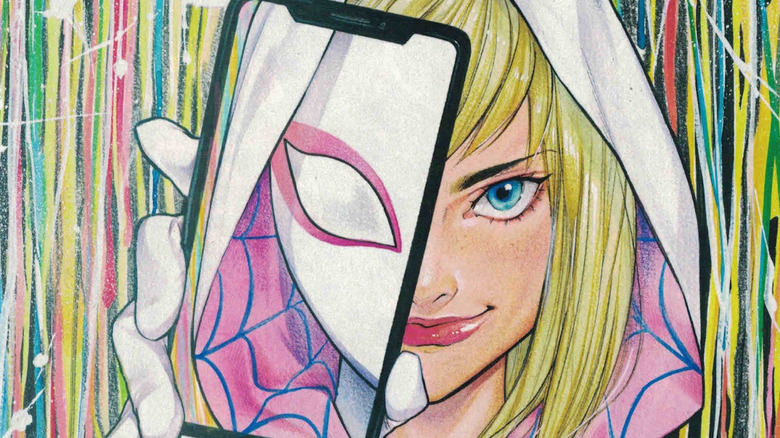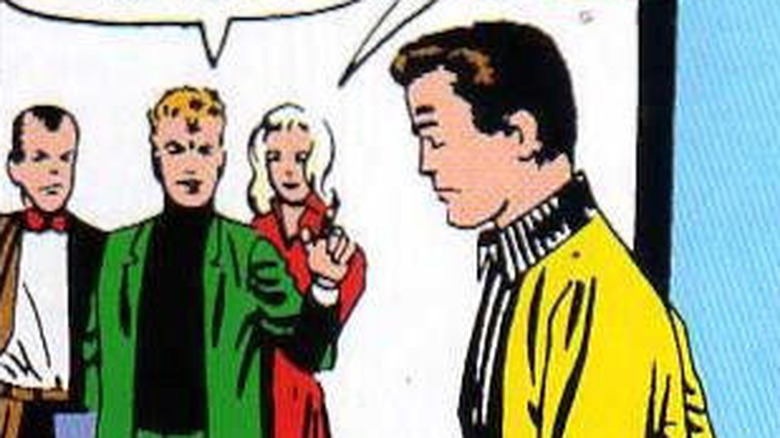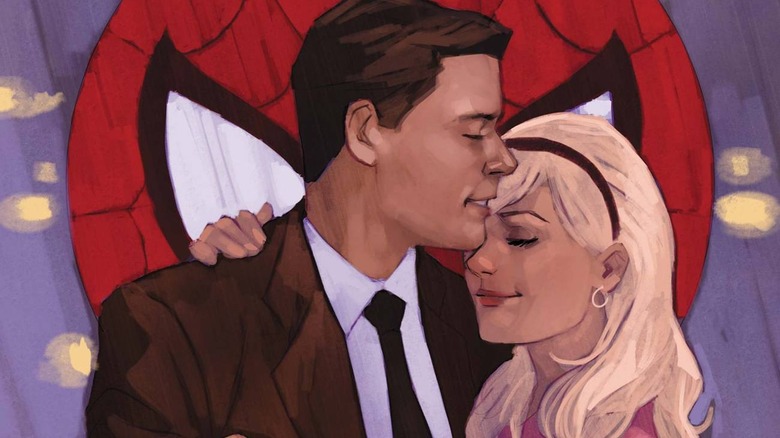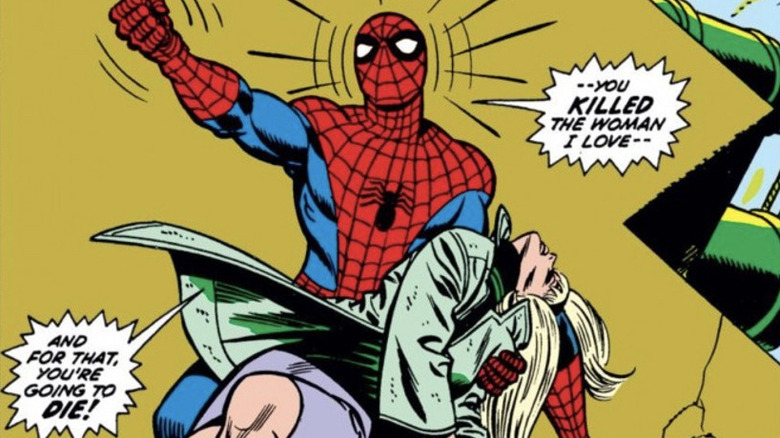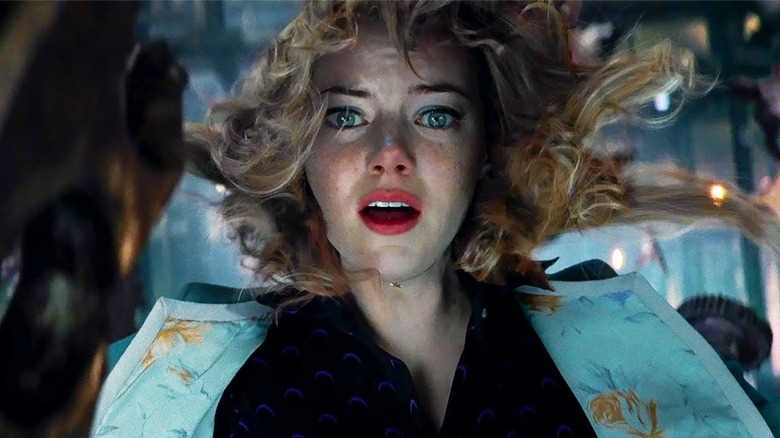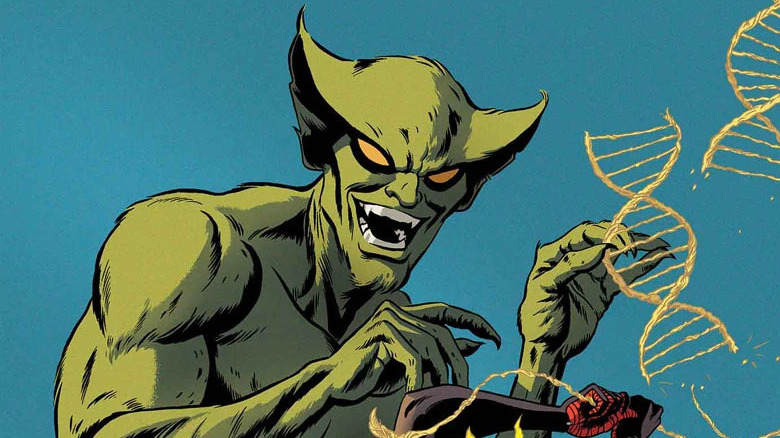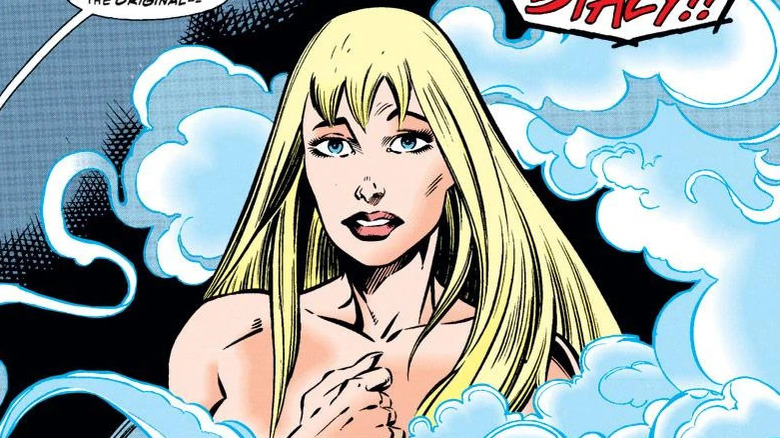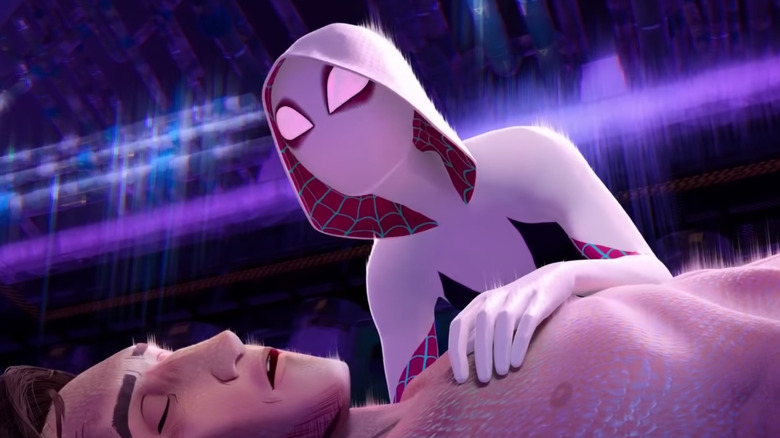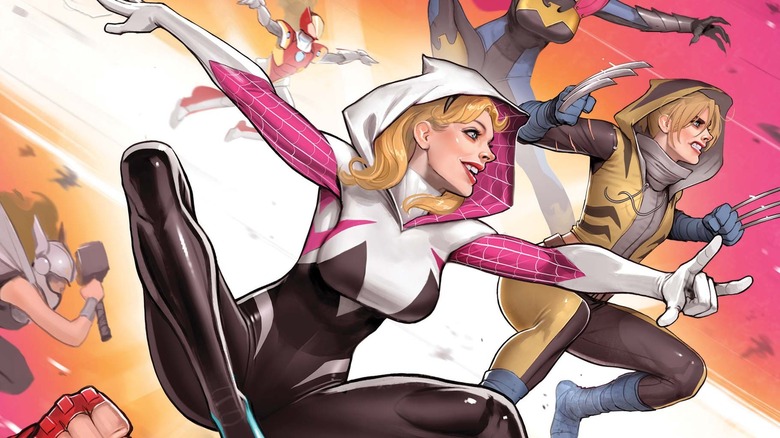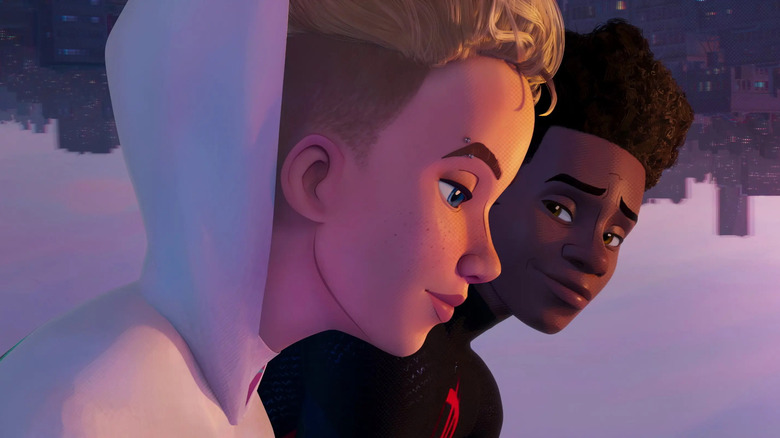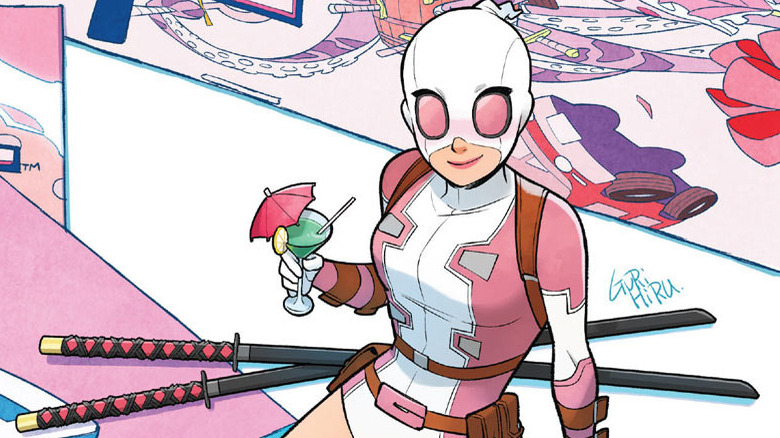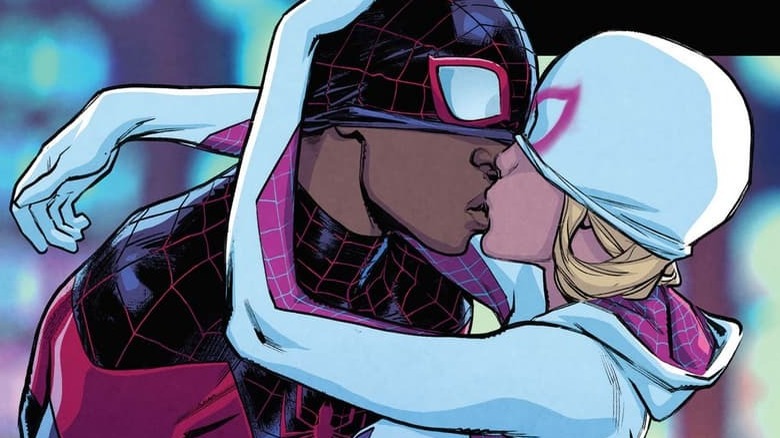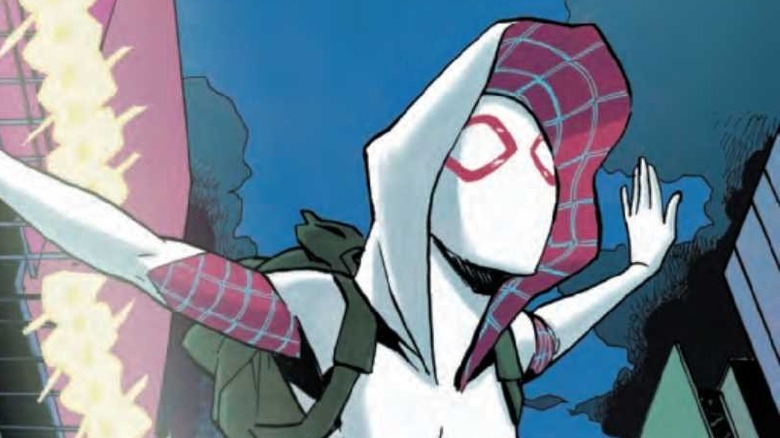The Untold Truth Of Gwen Stacy
Although the character was featured heavily in 2018's "Spider-Man: Into the Spider-Verse," audiences for "Spider-Man: Across the Spider-Verse" are receiving a ton more backstory on Gwen Stacy (voiced by Hailee Steinfeld), one of the more fascinating characters in the Sony slice of Marvel's cinematic universe. Of course, the character dates way back in the comics, long before any mention of multiverses, or even Spider-People who aren't Peter Parker.
Gwen Stacy is one of the more significant love interests in Peter Parker's comic book stories, whose tragic fate would not only shape the character for years to come, but also the history of comic book storytelling itself. Though her iconic status pales in comparison to Peter's more wild and passionate romance with Mary Jane Watson, many comic book fans prefer to see Gwen as the love of Peter Parker's life, even if her creators eventually decided the two weren't meant to be.
Gwen Stacy could have simply served as a plot device in the story of Peter Parker; instead, her popularity among Marvel fans has taken her from damsel in distress to a superhero in her own right. No longer the relatively-straightforward love interests once portrayed by Emma Stone and Bryce Dallas Howard in live action "Spider-Man" movies, the "Spider-Verse" films portray Gwen as far more competent, complicated, and commanding. Rewinding to her earliest comic book origins, the character has always stood out.
Gwen Stacy's design was inspired by Stan Lee's love life
When Gwen Stacy was first introduced in 1965's "The Amazing Spider-Man #31, Marvel's friendly neighborhood superhero had only been around for about three years, although he had become one of Marvel's most popular characters in that short amount of time.
Peter Parker encountered his fair share of romantic interests during those early years; there was Betty Brant, Liz Allan, and of course, Mary Jane, who somewhat mirrored Peter's attraction towards superheroism in her own attraction to the Spider-Man persona. The introduction of Gwen Stacy would be important for the Peter character – and for Stan Lee as well.
Lee claimed multiple times that the design for Gwen was inspired by his wife Joan, who passed away in 2017; he'd follow one year later. In a 2017 interview, Stan Lee attempted to explain the power of his muse.
"I took one look at her," he recalled. "And she was the girl I had been drawing all my life."
Lee credits Joan — who he met in 1947 — with inspiring him to create Marvel superheroes like the Fantastic Four at lean times when he had contemplated leaving the comic book industry. Joan Lee's connection to the "Spider-Man" universe wasn't only limited to inspiration; she also voiced the character of Madame Web in the late '90s "Spider-Man: The Animated Series."
Peter Parker initially met Gwen Stacy in college
Many comic book interpretations of Gwen Stacy, as well as adaptations in film and TV, have depicted her and Peter Parker as high school sweethearts, even flirtatious prior to Peter being bitten by the radioactive spider. In Stacy's comic book debut, however, she and Peter met at Empire State University, a fictional school attended by Marvel characters like Emma Frost, Squirrel Girl, and Johnny Storm. Though their first meetings were standoffish (Peter, after all, was grappling with an ill Aunt May), the two eventually bonded over their shared love of science. Soon, they began dating.
As a romantic interest for Peter Parker, Gwen differed greatly from Spider-Man's previous paramours. A science major herself, Gwen was attracted to Peter's intellect rather than any superpowers. This is in stark contrast to Mary Jane, attracted to Peter's persona as Spider-Man, thereby making the two love interests a manifestation of Peter Parker's ceaseless battle between power and responsibility, as Uncle Ben warned him about.
Gwen's romance with Peter Parker also carries with it additional stakes in that her ill-fated police captain father, George Stacy, dies as a result of Peter's actions. His dying words beg Spider-Man to protect Gwen. Though their romance should theoretically be simple, co-ed puppy love, it's far more complicated — ultimately, in many tellings of their story (and alluded to in "Across the Spider-Verse"), they are doomed.
Gwen was supposed to be Peter's main love interest
Gwen Stacy's romance with Peter not only carried dramatic stakes for the web-slinger's comic book story, but she was meant to have an even greater role. Mostly due to Stan Lee's own preference for Gwen, Parker's blonde-haired beau played a central role in the stories of Spider-Man, until readers of Marvel Comics showed a greater interest in the more carefree, wild Mary Jane.
"[Lee] had always felt that Mary Jane Watson was a better potential romantic foil for Peter than Gwen Stacy," Marvel Comics writer Gerry Conway said during a 2021 panel.
Despite Stan Lee's personal affection for Gwen, Conway felt strongly that not making Mary Jane and Peter a romantic option would be a missed opportunity; readers tended to agree. But that didn't stop Lee from protesting when Conway came up with an idea that would take Gwen Stacy out of Peter Parker's life for good — and in the process, become one of the most famous moments in comic book history.
She was killed off to make room for Mary Jane Watson
In one of the most significant comic book issues of Spider-Man's long and storied history, "The Amazing Spider-Man #121," released in 1973 and sub-titled "The Night Gwen Stacy Died," saw the Peter/Gwen storyline end in tragedy.
After Norman Osborn (a.k.a. the Green Goblin) learned Spider-Man's true identity, he kidnapped Gwen and lured the web-slinger to the George Washington Bridge. In the comic's climactic moment, the Goblin hurled Gwen off the bridge, forcing Peter to try and save her; his spider-web appeared to catch her in time, but the attempted rescue snapped her neck.
Although Gwen's fate would be a defining moment, that almost wasn't the case. After editors had suggested killing off an important character, thoughts turned from Aunt May to Gwen and Mary Jane, the options being whittled down by Conway and illustrator John Romita Sr. As Romita would recount in 2015, the choice of Gwen was just bad timing for her; at that particular moment, she was the more significant character in Peter's love life.
In the years to come, Stan Lee would be frequently critical of Conway and Romita's decision to off Gwen Stacy. Interestingly, the cause of her death was also controversial; after much confusion and debate, Marvel Comics would publish an editor's note several issues later, clarifying that Gwen's death was, in fact, caused by the whiplash of Peter's web.
Gwen Stacy's death changed the history of comic books
Needless to say, the decision to kill off Gwen Stacy shocked comic book readers around the world. But this became far more than just another plot twist in the serialized storytelling of Peter Parker's life.
As Arnold T. Blumberg described in his 2003 essay "'The Night Gwen Stacy Died': The End of Innocence and the Birth of the Bronze Age," the death represented "a time when a defeated hero could not save the girl, when fantasy merged uncomfortably with reality, and mortality was finally visited on the world of comics."
On a wider scale, the storyline would herald a huge shift in comic book storytelling, one that coincided with the end of the Silver Age and the beginning of the Bronze one. A major distinction between these two periods was in their tone; the stories of the Silver Age were dramatically affected by the 1954 Comics Code Authority, forcing content to become more regulated and squeaky-clean for audiences. In contrast, the Bronze Age was much darker, with consequential moments such as Gwen Stacy's death becoming the norm.
Gwen also became the first of many romantic interests to be killed off for the sake of a male character's story; this would later become such a cliche that it earned the name "The Gwen Stacy Syndrome." While the consequences of Gwen's death would be felt for decades to come, for Peter Parker's more immediate future, it meant new threats.
Her loss creates some of Spider-Man's fiercest foes
Peter Parker wouldn't be the only Marvel Comics character grieving the death of Gwen Stacy, nor the only one who loved her. Another character plagued by her death was Miles Warren, a former pupil of the High Evolutionary who became Gwen's teacher at Empire State University. Having fallen in love with his student, Miles blamed Spider-Man for her death and became the supervillain known as the Jackal, hellbent on recreating Gwen through cloning.
Gwen's death led to the creation of darker Marvel Comics characters like Frank Castle (aka "the Punisher") a soon-to-be-popular character in his own right who first encountered Spider-Man during his conflicts with the Jackal, who manipulates the Punisher into hunting down Spider-Man out of revenge for Gwen's death.
Gwen's death did result, believe it or not, in some positive change for Peter's life. As Peter grieved Gwen, Mary Jane's consoling brought the two former flames closer, eventually leading them to a more mature, grounded relationship than they had in past comic book storylines. As time went on, and Stan Lee continued to protest the decision to kill Gwen Stacy, the result was one of the more divisive plotlines in early Spider-Man comic books.
Stan Lee insisted that Gwen be brought back to life
As editor-in-chief of Marvel Comics, Stan Lee faced the brunt of criticism from fans upset by the decision to kill off Gwen Stacy. Since Lee in essence agreed with them, he had something of a mandate when he approached writer Gerry Conway, insisting that they find a way to reverse the death. Conway eventually relented, utilizing the Jackal's background in cloning as the foundation of a storyline that had the supervillain resurrecting Gwen; Peter Parker ends up fighting his own clone, and the "new" Gwen Stacy ultimately decides to start her own life instead of one alongside Peter.
Future storylines in the comics would also re-introduce cloning as a means of reviving Gwen. One of the more fascinating ones came with 2004's "Sins Past," which had Peter and Mary Jane discovering the existence of twins named Sarah and Gabriel, the children of Gwen Stacy and Norman Osborn, who'd had a secret affair that ultimately resulted in Osborn killing her. This storyline would be retconned in later storylines by explaining that it was all an elaborate ruse by Harry Osborn to manipulate Peter Parker and his father.
Gwen Stacy's resurrection would also serve as a significant plot point in the 2016 storyline "Dead No More: The Clone Conspiracy," wherein Peter's clone, Ben Reilly, returns under the guise of the Jackal with a resurrected Gwen Stacy at his side.
Gwen was also revived during House of M
Regarded as another pivotal moment in the history of Marvel Comics, "House of M" was released in 2005 and written by Brian Michael Bendis, creator of Miles Morales, Jessica Jones, RiRi Williams and others.
The series centers on the mental breakdown of the Scarlet Witch, forcing the Avengers and X-Men to band together to subdue her. However, it also features a big plot twist for the story of Peter Parker — one that brings Gwen Stacy back into the fold.
Ultimately, the group's failure to stop the Scarlet Witch results in reality being shaped to give every superhero a new life in a world where mutants are the superior race, ruled by Magneto. One of the Avengers impacted by this change is Peter Parker, who wakes up in bed next to Gwen Stacy in one of the biggest cliffhangers of the comic book storyline.
Marvel's superheroes realize that the Scarlet Witch has given life to their deepest desires; for Peter, his happiest life is to be a celebrity superhero, married to Gwen Stacy and fathering a child with her. Though Spider-Man ultimately answers the call to oppose the Scarlet Witch, once everything goes back to normal (or rather, as normal as it could be considering that the Scarlet Witch wipes out most of the mutants in the world), Peter mourns the loss of his perfect life.
On Earth-65, Gwen Stacy is the one who loses Peter Parker
In other multiverses, Gwen Stacy's story isn't that of the damsel-in-distress, but the hero herself. Those who have seen "Spider-Man: Across the Spider-Verse" got a deep dive into the events that led the Gwen Stacy on Earth-65 to become Spider-Gwen, but few probably know that those events have their origins in Marvel Comics. Spider-Gwen made her debut in 2014's "Edge of Spider-Verse" comic book series, where the heroic character is introduced in a similar manner to the opening sequence of "Across the Spider-Verse."
After being bitten by a radioactive spider, Gwen Stacy assumes the role of Spider-Woman in her universe while her boyfriend, Peter Parker, suffers from bullying. Parker, fed up with being the victim of abuse, uses Dr. Curt Connors' serum to become the Lizard and attack the school dance, where she's fatally killed by Spider-Gwen, who becomes a fugitive targeted by the NYPD — led by her own father, George Stacy.
Following Spider-Gwen's reception from the "Spider-Verse" storyline, she was given her own ongoing series helmed by comic book writer Jason Latour. Throughout the series, she encounters common Spider-Man antagonists like Kingpin, Vulture, and Kraven the Hunter, while also making alliances with Matt Murdock and Jessica Drew, the Spider-Woman of Earth-616. Spider-Gwen has made numerous appearances in other "Spider-Verse" storylines as a totem of the Spider-Army, formed by Spider-UK in opposition of the Inheritors, whose mission is to hunt all kinds of Spider-People across the multiverse.
Other variants of Gwen have been important in the Spider-Verse
While the Gwen Stacys of Earth-616 and Earth-65 are perhaps the most significant variants of Peter Parker's love interest in Marvel's comic book universe, the character has nevertheless remained an important recurring figure throughout the multiverse. Some Gwen Stacys have become respected superheroes like Spider-Gwen, while others have even become antagonists towards Peter Parker or other variants of Spider-Man in other alternate dimensions.
For instance, there's the Gwen Stacy of Earth-8, who briefly appears during the Miles Morales/Gwen Stacy crossover storyline "Sitting In A Tree," where it's revealed that Gwen and Miles married and became part of the Amazing Eight, which also included "Spider-Verse" characters like SP//dr, Spider-Ham, and their children, Charlotte and Max, who masqueraded as Spider-Girl and Spider-Boy, respectively. Meanwhile, in Spider-Ham's home universe, Gwen Stacy is a penguin named Guin Stacy.
Sadly, other Gwen Stacy variants throughout the multiverse weren't lucky enough to become good guys. In the "Ultimate Marvel" universe, Gwen Stacy is killed by Carnage, and is later revived as a clone and transformed into the monstrous Spider-Man villain. Other versions of Gwen have also become infected with the Venom symbiote, turning her into one of Spider-Man's biggest rivals in a storyline that results in Peter Parker's death, forcing Gwen and Mary Jane to mourn him together. During the "Secret Wars" storyline, there's even a version of Gwen encountered on Battleworld that has the powers of Wolverine.
Gwen was excluded from the cartoon for a very specific reason
When the stories of Spider-Man were adapted into a Saturday morning cartoon on Fox Kids in 1994, one might assume that Gwen Stacy would be a shoe-in for the series. Surprisingly, the character was omitted from the animated series entirely. In her place, the creators added in Felicia Hardy (also known as the seductive supervillain Black Cat) as a romantic interest for Peter Parker to compete with Mary Jane for his affection.
In an interview with Jon Semper, the writer of the animated series was questioned on the absence of Gwen.
"All roads with Gwen lead to death," he explained. "Which we couldn't really do on Saturday morning."
Nevertheless, "The Night Gwen Stacy Died" would ultimately be adapted into the animated series with the episode "Turning Point," where Green Goblin discovers Spider-Man's secret identity and subsequently throws Mary Jane into a time portal, not to return until an entire season later.
Despite her absence in "Spider-Man: The Animated Series," Gwen Stacy played a significant role as one of Peter's love interests in the 2008 animated series "The Spectacular Spider-Man," which aired for two seasons on The CW and Disney XD. However, in that series, Gwen wasn't killed by the Green Goblin, but instead ended up with Harry Osborn in an effort to keep him from turning evil, leaving Peter all alone.
She made her live-action debut in Spider-Man 3
Until the third Sam Raimi-led "Spider-Man" film in 2007, Peter Parker's love interest in the movies had been Kirsten Dunst's Mary Jane, with whom he famously shared a sultry upside-down kiss in the first film. Despite occasional flirtations with Peter's Daily Bugle co-worker Betty Brant (Elizabeth Banks) the biggest threat to Peter's relationship with MJ came in "Spider-Man 3" via Gwen Stacy, played by Bryce Dallas Howard.
Suffice it to say, Gwen's storyline in "Spider-Man 3" was quite different than the character's role in the comics. In the film, Peter and Gwen meet after Spider-Man rescues his university lab partner from near-death. After Peter later becomes corrupted by the Venom symbiote, he begins dating Gwen in an effort to make Mary Jane jealous, though Gwen removes herself from the situation when she realizes she's being used. Even though the character was added to the film due to producer notes, Howard was careful to remain loyal to Gwen's role as Peter's first love in the comics.
Soon after, the conclusion of Raimi's tenure on the "Spider-Man" films meant that Howard's portrayal of Gwen was one-and-done. When People Magazine caught up with Howard more than a decade later and asked if she'd be willing to reprise the role now that multiverse storylines seemed to make such things possible, Howard responded, "I would always be game."
Emma Stone was cast as Gwen Stacy for her chemistry with Andrew Garfield
Even though Gwen Stacy appeared in Sam Raimi's "Spider-Man 3," mainstream audiences became familiar with a more faithful version of the character in Marc Webb's "The Amazing Spider-Man," which released in 2012 starring Andrew Garfield as Peter Parker. Several actresses were in the running for Gwen, including Mary Elizabeth Winstead, Imogen Poots, and Dianna Agron. However, Emma Stone landed the role in 2010.
Despite a wide search for the perfect Gwen Stacy, Stone proved to be a no-brainer once she did a chemistry test with Andrew Garfield.
"We got on really well as people," Garfield told MTV News in 2012. "That was the fun stuff: In between, we'd just mess around, and I felt, 'Ah, this is different.' I wasn't really aware what was happening in the screen test. She keeps you on your toes, and that wakes you up."
Though neither of them likely anticipated their on-screen chemistry to translate to an off-screen romance, it did, lasting from 2011 to 2015. Some fans cited their chemistry as one of the highlights of the Webb films, particularly the 2014 sequel "The Amazing Spider-Man 2."
Despite positive fan reception to Stone's version of the character, fans were divided when the filmmakers decided to adapt her death in the second film — even if it was an aspect of the character that Stone had anticipated ever since being cast in the role. The storyline would pay off years later, of course, when Garfield put on the spider suit again for a high-profile cameo in 2021's "Spider-Man: No Way Home," redeeming himself for failing to save Gwen by rescuing Zendaya's MJ from the same fate.
Gwenpool was born out of a comic book variant cover
While Gwen Stacy has had many comic book incarnations as both Peter Parker's doomed damsel in distress and as a superhero with her own tragic backstory, fans have also latched on to more light-hearted versions of the character. One of these came entirely on accident, but has become one of the more popular Marvel Comics characters in recent years. The character of Gwenpool — a cross between Gwen Stacy and Deadpool — originated from a variant cover of a Deadpool comic series from 2015.
Based on the popularity of the cover alone, Marvel produced several one-off comics featuring the character before giving her an ongoing comic book series of her own in 2016. In the series, Gwen Poole is revealed to be a teenage comic book superfan from "the real world" who enters the Marvel comic book universe and becomes a fourth-wall breaking superhero just like Wade Wilson. The character garnered significant attention from the comic book community for becoming the first asexual and aromantic Marvel Comics character.
Although the character has remained a breezier part of the Marvel universe, fans have latched onto the character for the inclusivity of an underrepresented sexuality. Additionally, Gwenpool's iconic blonde hair with pink streaks became part of the redesign for Gwen Stacy of Earth-65 in 2023's "Spider-Man: Across the Spider-Verse," potentially opening up the Sony-verse character to taking on the mantle of Gwenpool at some point.
Spider-Gwen sparked a brief romance with Miles Morales
While Gwenpool was significant representation for asexual comic book fans, Gwen Stacy of Earth-65 has been no stranger to romantic storylines. Particularly, her romance with Miles Morales taking center-stage in the crossover storyline "Sitting In A Tree," which was published over several volumes in "Spider-Man" and "Spider-Gwen" comic books in 2017. Helmed by Miles Morales creators Brian Michael Bendis and Sarah Pichelli, the storyline finds Miles and Gwen's relationship blossoming when they team up to rescue his father.
Although the two have a lot to bond over as relatively young and fresh Spider-people, the relationship ends up coming to an end as the two decide to just stay friends. However, it's a much more amicable end for their relationship than Gwen Stacy's other comic book variants, given they're still able to work together as a team and avoid tragedy. Still, that didn't make the short-lived romance any less beloved by diehard fans of the respective characters.
The romance between the two characters is also a vital part of "Spider-Man: Across the Spider-Verse," where the lingering feelings of Miles over Gwen lead him into trouble with Miguel O'Hara's Spider-Society. Amy Pascal, producer at Sony Pictures, even described the film to Empire Online as "a love story between Miles and Gwen"; of course, their relationship is fraught by the end of the film, with the stakes raised higher than ever for 2024's "Beyond the Spider-Verse."
Ghost-Spider draws inspiration from the fate of her variants
In the years since Gwen Stacy's popularity has increased following her appearance as Spider-Gwen in "Spider-Man: Into the Spider-Verse," the character has had a lot of interaction with the Spider-Verse. The "Spider-Geddon" comic book storyline, which began in 2018, tied in the Gwen Stacy of Earth-65 with Spider-People from across the multiverse, including the Peter Parker from Insomniac's video game series.
Eventually, Gwen Stacy finds herself living on Earth-616, where she begins adopting the superhero moniker of "Ghost-Spider," which was coined by Miles Morales after he had mistakenly thought she died. She later takes on the nickname as her own in honor of the fallen Gwen Stacys throughout the multiverse, and begins attending college in Earth-616, maintaining her secret identity. She also encounters Spider-Man villains such as Swarm, Carnage (who has taken over Mary Jane Watson), and the version of the Jackal who loved her Earth-616 variant.
Along the way, Earth-65's Gwen Stacy also teams up with her own variants from other multiverses in the 2022 storyline "Gwenverse." However, these variants aren't competing with Earth-65's Gwen for the role of Spider-Man, as they take on other forms of Marvel superheroes like Captain America, Wolverine, Thor, and Iron Man to battle the supervillain Nightbird, who is yet another variant of Gwen Stacy that was trained by the superhero Nighthawk and becomes the leader of the Terminal Six — whose members include Doctor Cephalopod and Glam Goblin, among others.
